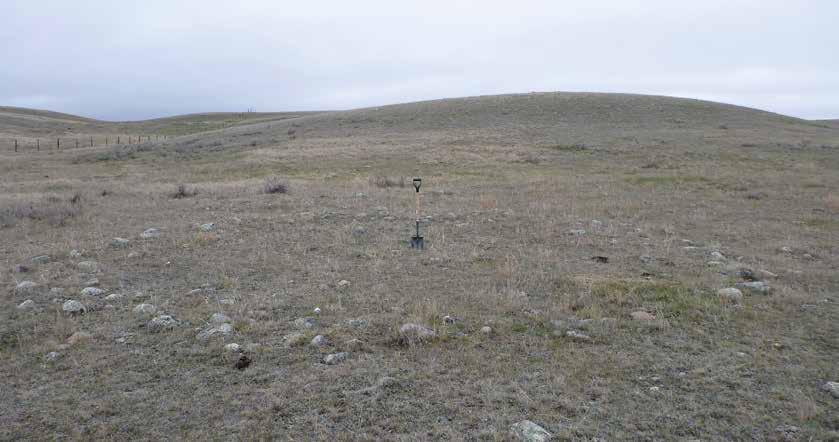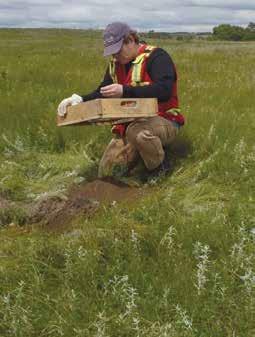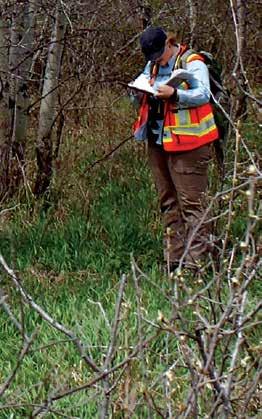
4 minute read
Environmental Services
Saving the past
A CanNorth archaeologist conducting a Heritage Resources Impact Assessment.

there are rich and diverse heritage resources just below our feet. Heritage resources are non-renewable, and each resource is unique and important. lost or disturbed heritage resources are a loss for everyone. as defined by the Heritage Property act of saskatchewan, heritage resources include archaeological or paleontological objects and sites, built heritage and structures of architectural or historical value, and any site or property where it is reasonable to suspect that heritage resources may be found. the act protects heritage resources on both private and provincial Crown land and is administered by saskatchewan’s Ministry of Parks, Culture and sport’s (PCs) Heritage Conservation branch (HCb).
It is important to know the process for compliance with provincial heritage legislation when planning or managing a new development. a first step is to determine if the development is located on heritage-sensitive land by using the PCs developer’s online screening tool. If the development is located on heritage-sensitive land, the project will need to be submitted to the HCb for further review. If the HCb decides that the development has moderate-to-high potential to disturb heritage resources, the HCb may require that a Heritage resources Impact assessment be completed before any construction starts.
the importance of preserving and protecting heritage has been acknowledged in the United Nations Declaration on the rights of Indigenous People, as well as by provincial heritage groups such as Heritage saskatchewan and the saskatchewan archaeological society. Not follow-
A stone circle found during a Heritage Resources Impact Assessment (shovel in centre of circle).
ing the proper steps to protect heritage resources may result in regulatory or legal non-compliance, which could lead to serious consequences. further negative consequences of non-compliance with heritage legislation may include project delays, lowered investor and public confidence, potential community backlash, and damage to personal and corporate reputation. Protecting heritage can have a positive impact by connecting people to the past and by providing a sense of belonging, understanding, and wellbeing. In addition to being a legislative requirement, the management and protection of heritage resources helps us to better understand who we are and how we got here.
Canada North environmental services’ (CanNorth) heritage division has been helping developers and project managers navigate provincial legislation since 2011. CanNorth’s archaeologists are qualified and have a proven track record of successfully completing Heritage resources Impact assessments throughout saskatchewan, alberta, and Manitoba. CanNorth is based out of saskatoon and is 100 per
cent first Nations owned by the lac la ronge Indian band and is a Certified aboriginal business through the Canadian Council for aboriginal business. as such, CanNorth is mindful of the stakes when conducting Heritage resources Impact assessments for developments in saskatchewan and maximizes Indigenous community involvement, including integrating traditional knowledge, engaging local people, and creating employment and education opportunities.
CanNorth has been involved in many interesting heritage projects. CanNorth archaeologists were called in to investigate after a back-hoe operator uncovered several large bison skulls during an infrastructure project in saskatoon. Upon examination, CanNorth archaeologists determined that the skulls belonged to bison occidentalis, a species of extinct bison that roamed around the saskatoon area between 5,000 and 10,000 years
One of the bison occidentalis skulls discovered in Saskatoon. Note: The approximate size of a modern bison is outlined in red.
ago; the skulls were much larger than our contemporary bison. CanNorth archaeologists were able to collect important data during the Heritage resources Impact assessment, satisfying the HCb’s compliance requirements for the project. the bison skulls were further analyzed in CanNorth’s laboratory and sent to the royal saskatchewan Museum’s t.rex Discovery Centre in eastend, saskatchewan, where they are available for research and study. CanNorth’s involvement and consultation in this project helped the client achieve compliance with the Heritage Property act and complete the development ahead of schedule and under budget. the process also resulted in the collection of valuable scientific data that could help us better understand our ancient environment.

Please do not hesitate to contact CanNorth to discuss any heritage questions or future projects. s
211 Wheeler Street, Saskatoon, SK S7P 0A4 T: (306) 652-4432 • F:(306) 652-4431 E: info@cannorth.com • www.cannorth.com
An aboriginal-owned consulting firm
providing cost-effective professional environmental services in:

• Environmental Impact Assessment • Environmental Baseline Studies • Project Permitting and Approvals • Construction Monitoring • Aquatic and Fish Studies • Aquatic Toxicology • Water Quality Investigations • Ecological and Human Health Risk
Assessments • Hydrology • Species-at-Risk Surveys • Wildlife, Vegetation, and Soil
Assessments • Habitat Restoration and Compensation
Planning • Mapping Services • Heritage Resources Impact Assessments • Specialty Socio-Economic Services










